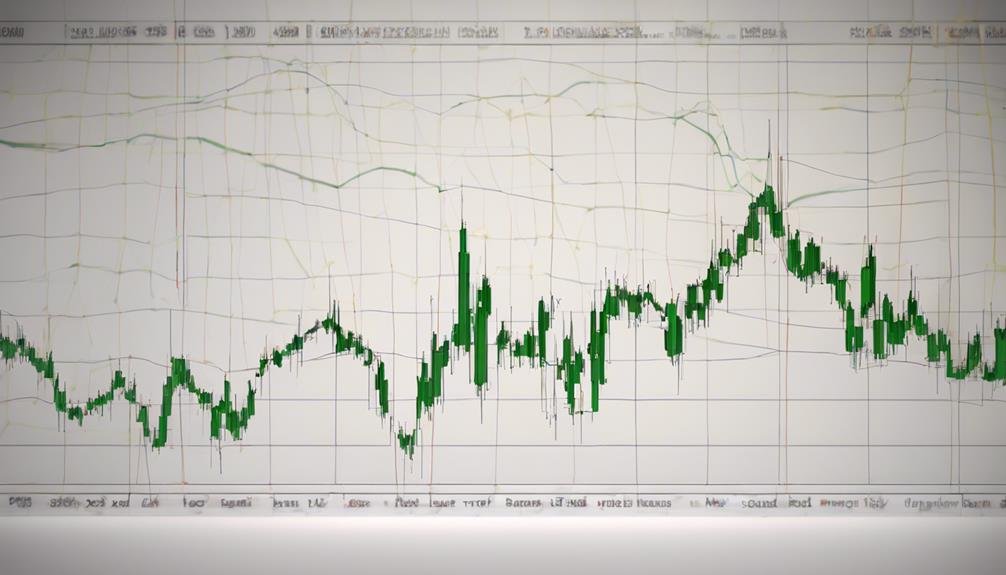Bollinger Bands: What They Are, and What They Tell Investors
Bollinger Bands are essential for investors, providing insights into market volatility, identifying overbought/oversold conditions, and signaling buy/sell opportunities when prices touch the bands. Calculated through a simple moving average, upper and lower bands, and standard deviation, they aid in statistical analysis and measure volatility. These bands inform strategic decision-making, enhance trading strategies when combined with other indicators, and help manage risks by identifying potential price reversals and market trends. Understanding the squeeze and breakouts can lead to capitalizing on opportunities, making informed decisions, and managing market uncertainties effectively. Further exploration of Bollinger Bands can deepen your understanding of market dynamics.
Key Takeaways
- Essential tool for understanding market volatility.
- Identify overbought and oversold conditions.
- Interpret buy/sell opportunities when prices touch bands.
- Can be used in conjunction with other technical indicators.
- Provide insights into potential price reversals and market trends.
Key Features of Bollinger Bands
Within the domain of technical analysis, the key features of Bollinger Bands serve as essential tools for investors and traders seeking to gauge market volatility and identify potential trading opportunities. As volatility indicators, Bollinger Bands help in understanding the price volatility of a security by visually representing it through the bands' width.
Widely used in technical analysis, these bands assist in recognizing overbought and oversold conditions in the market. Traders interpret signals when prices touch the bands, indicating potential buy or sell opportunities. Additionally, the bands can be used in conjunction with other technical indicators to enhance trading strategies.
The ability to adapt to changing market conditions and provide insights into potential price movements makes Bollinger Bands a valuable asset for traders and investors alike.
Understanding Bollinger Bands Calculation
The calculation of Bollinger Bands involves deriving three key lines – a simple moving average, an upper band, and a lower band – based on specific mathematical computations applied to the price data of a security.
By computing the 20-day SMA of a security and measuring the standard deviation to assess variance, investors can determine the upper and lower bands by multiplying the standard deviation by 2.
Adding and subtracting the standard deviation from each point along the SMA enables the creation of bands that aid in statistical analysis and volatility measurement.
These bands provide valuable insights into the potential price movement and help investors in gauging market dynamics accurately.
Applying Bollinger Bands in Trading
Applying Bollinger Bands in trading involves utilizing the bands' signals and volatility measurements to inform strategic decision-making in financial markets. Traders often incorporate Bollinger Bands into their trading strategies for evaluating potential buy/sell signals based on price movements relative to the bands. Additionally, the volatility analysis provided by Bollinger Bands aids traders in understanding the level of market volatility at a given time, influencing their risk management and trade execution. By combining Bollinger Bands with other technical indicators, traders can enhance their trading strategies and make more informed decisions. The table below summarizes key aspects of applying Bollinger Bands in trading:
| Aspect | Description | Importance |
|---|---|---|
| Buy/Sell Signals | Generated when price touches bands | Identifying entry points |
| Volatility Analysis | Band width indicates volatility level | Managing risk exposure |
| Combining with Indicators | Enhances trading strategies | Confirming signals |
| Risk Management | Utilizing volatility measurements | Adjusting position sizes |
Exploring the Squeeze and Breakouts
Exploring the dynamics of the Squeeze and Breakouts within Bollinger Bands reveals key insights into market volatility and potential trend shifts.
The Squeeze occurs when the bands come close together, indicating a period of low volatility. This signals a potential future increase in volatility, suggesting an impending price breakout.
Breakouts, significant price moves above or below the bands, can be key moments in trading. While breakouts themselves are not trading signals, they can indicate potential opportunities for investors to contemplate implementing breakout strategies.
Understanding these volatility patterns and incorporating breakout strategies can be valuable tools for traders looking to capitalize on market movements within the framework of Bollinger Bands.
Managing Risks With Bollinger Bands
Utilizing Bollinger Bands as a risk management tool enhances traders' ability to navigate market uncertainties and optimize trading strategies. When using Bollinger Bands for risk management and volatility analysis, traders can benefit from:
- Early Warning Signals: Bollinger Bands can indicate potential price reversals, helping traders manage risks by identifying entry and exit points more effectively.
- Volatility Insights: By analyzing the width of the bands, traders can gauge the level of volatility in the market, aiding in risk assessment and position sizing.
- Confirmation of Trends: Bollinger Bands can assist in confirming market trends, enabling traders to make informed decisions while managing risks associated with false signals and market fluctuations.
Conclusion
To sum up, Bollinger Bands are a valuable tool for investors to assess market volatility and identify trading opportunities. With over 80% of breakouts occurring outside the bands, understanding how to interpret these indicators can greatly enhance trading decisions.
By recognizing patterns such as 'the squeeze' and utilizing other technical indicators, investors can improve their trading strategies and overall performance in the financial markets.







